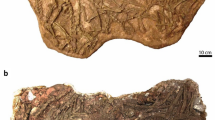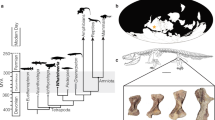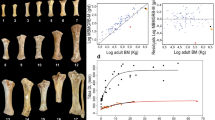Abstract
Did dinosaurs grow in a manner similar to extant reptiles, mammals or birds, or were they unique1? Are rapid avian growth rates an innovation unique to birds, or were they inherited from dinosaurian precursors2? We quantified growth rates for a group of dinosaurs spanning the phylogenetic and size diversity for the clade and used regression analysis to characterize the results. Here we show that dinosaurs exhibited sigmoidal growth curves similar to those of other vertebrates, but had unique growth rates with respect to body mass. All dinosaurs grew at accelerated rates relative to the primitive condition seen in extant reptiles. Small dinosaurs grew at moderately rapid rates, similar to those of marsupials, but large species attained rates comparable to those of eutherian mammals and precocial birds. Growth in giant sauropods was similar to that of whales of comparable size. Non-avian dinosaurs did not attain rates like those of altricial birds. Avian growth rates were attained in a stepwise fashion after birds diverged from theropod ancestors in the Jurassic period.
This is a preview of subscription content, access via your institution
Access options
Subscribe to this journal
Receive 51 print issues and online access
$199.00 per year
only $3.90 per issue
Buy this article
- Purchase on Springer Link
- Instant access to full article PDF
Prices may be subject to local taxes which are calculated during checkout



Similar content being viewed by others
Change history
16 December 2015
A Correction to this paper has been published: https://doi.org/10.1038/nature16488
References
Ricqlès, A. de. in A Cold Look at the Warm-Blooded Dinosaurs (eds Thomas, D. K. & Olson, E. C.) 103–139 (Westview, Boulder, 1983).
Chinsamy, A., Chiappe, L. M. & Dodson, P. Growth rings in Mesozoic birds. Nature 368, 196–197 (1994).
Chinsamy, A. Physiological implications of the bone histology of Syntarsus rhodesiensis (Saurischia: Theropoda). Palaeontol. Afr. 27, 77–82 (1990).
Chinsamy, A. Bone histology and growth trajectory of the prosauropod dinosaur Massospondylus carinatus Owen. Mod. Geol. 18, 319–329 (1993).
Varricchio, D. J. Bone microstructure of the Upper Cretaceous theropod dinosaur Troodon formosus. J. Vertebr. Paleontol. 13, 99–104 (1993).
Curry, K. A. Ontogenetic histology of Apatosaurus (Dinosauria : Sauropoda): new insights on growth rates and longevity. J. Vertebr. Paleontol. 19, 654–665 (1999).
Horner, J. R., Ricqlès, A. de & Padian, K. Long bone histology of the hadrosaurid dinosaur Maiasaura peeblesorum: growth dynamics and physiology based on an ontogenetic series of skeletal elements. J. Vertebr. Paleontol. 20, 115–129 (2000).
Sander, P. M. Long bone histology of the Tendaguru sauropods: implications for growth and biology. Paleobiology 26, 466–488 (2000).
Ricqlès, A. de . Zonal “growth rings” in dinosaurs. Mod. Geol. 15, 19–48 (1990).
Rimblot-Baly, F., Ricqlès, A. de & Zylberberg, L. Analyse paléohistologique d'une série de croissance partielle chez Lapparentosaurus madagascariensis (Jurassique Moyen): essai sur la dynamique de croissance d'un dinosaure sauropode. Ann. Paléontol. 81, 49–86 (1995).
Reid, R. E. H. in The Complete Dinosaur (eds Farlow, J. O. & Brett-Surman, M. K.) 449–473 (Indiana Univ. Press, Bloomington, 1997).
Ricqlès, A. de, Meunier, F. J., Castanet, J. & Francillon-Vieillot, H. in Bone Vol. 3 (ed. Hall, B. K.) 1–78 (CRC, Boca Raton, 1991).
Castanet, J., Curry Rogers, K., Cubo, J. & Boisard, J. J. Quantification of periosteal osteogenesis in ostrich and emu: implications for assessing growth in dinosaurs. C.R. Acad. Sci. III 323, 543–550 (2000).
Erickson, G. M. & Tumanova, T. A. Growth curve of Psittacosaurus mongoliensis Osborn (Ceratopsia: Psittacosauridae) inferred from long bone histology. Zool. J. Linn. Soc. 130, 551–566 (2000).
Varricchio, D. J. in Encyclopedia of Dinosaurs (eds Currie, P. J. & Padian, K.) 282–288 (Academic, San Diego, 1997).
Sussman, M. Growth and Development (Prentice-Hall, New Jersey, 1964).
Case, T. J. On the evolution and adaptive significance of postnatal growth rates in the terrestrial vertebrates. Q. Rev. Biol. 53, 243–282 (1978).
Calder, W. A. III . Size, Function, and Life History (Harvard Univ. Press, Cambridge, Massachusetts, 1984).
Norell, M. A., Clark, J. M. & Makovicky, P. J. in New Perspectives on the Origin and Early Evolution of Birds; Proc. Int. Symp. in Honor of John H. Ostrom (eds Gauthier, J. & Gall, L.) (Special Publ. Peabody Mus. Nat. Hist., New Haven, in the press).
Wells, J. W. Coral growth and geochronometry. Nature 197, 948–950 (1963).
Case, T. J. Speculations on the growth rate and reproduction of some dinosaurs. Paleobiology 4, 320–328 (1978).
Bakker, R. T. The Dinosaur Heresies (Kennsington, New York, 1986).
Xu, X., Zhou, Z. & Wang, X. The smallest known non-avian theropod dinosaur. Nature 408, 705–708 (2000).
Appenzeller, T. Argentine dinos vie for heavyweight title. Science 266, 1805 (1994).
Castanet, J. & Smirina, E. Introduction to the skeletochronological method in amphibians and reptiles. Ann. Sci. Nat. Zool. 11, 191–196 (1990).
Anderson, J. F., Hall-Martin, A. & Russell, D. A. Long-bone circumference and weight in mammals, birds and dinosaurs. J. Zool. A207, 53–61 (1985).
Thompson, D. W. On Growth and Form (Cambridge Univ. Press, New York, 1943).
Seebacher, F. A new method to calculate allometric length-mass relationships of dinosaurs. J. Vertebr. Paleontol. 21, 51–60 (2001).
Chiappe, L. M., Norell, M. A. & Clark, J. A. The skull of a relative of the stem-group bird Mononychus. Nature 392, 275–278 (1998).
Acknowledgements
We thank J. Horner and the staff of the Museum of the Rockies; M. Norell and staff of the American Museum of Natural History; A. Woodward and the Florida Fish and Wildlife Conservation Commission; and T. Tumanova, B. Breithaupt, P. Makovicky, M. Sander, D. Varricchio, E. Creech, R. Rogers, B. Erickson and K. Womble. This research was funded by the College of Arts and Sciences and Department of Biological Science of Florida State University.
Author information
Authors and Affiliations
Corresponding author
Rights and permissions
About this article
Cite this article
Erickson, G., Rogers, K. & Yerby, S. Dinosaurian growth patterns and rapid avian growth rates. Nature 412, 429–433 (2001). https://doi.org/10.1038/35086558
Received:
Accepted:
Issue Date:
DOI: https://doi.org/10.1038/35086558
This article is cited by
-
Osteohistology of a Triassic dinosaur population reveals highly variable growth trajectories typified early dinosaur ontogeny
Scientific Reports (2022)
-
Palaeohistology reveals a slow pace of life for the dwarfed Sicilian elephant
Scientific Reports (2021)
-
A fast-growing basal troodontid (Dinosauria: Theropoda) from the latest Cretaceous of Europe
Scientific Reports (2021)
-
The first theropod dinosaur (Coelurosauria, Theropoda) from the base of the Romualdo Formation (Albian), Araripe Basin, Northeast Brazil
Scientific Reports (2020)
-
Bone histology provides insights into the life history mechanisms underlying dwarfing in hipparionins
Scientific Reports (2018)
Comments
By submitting a comment you agree to abide by our Terms and Community Guidelines. If you find something abusive or that does not comply with our terms or guidelines please flag it as inappropriate.



